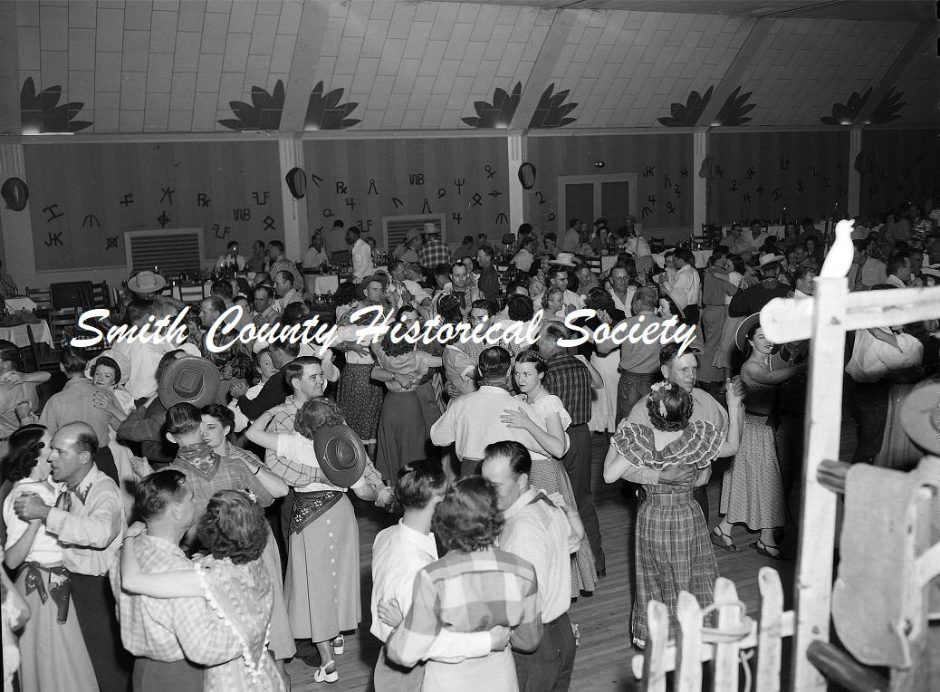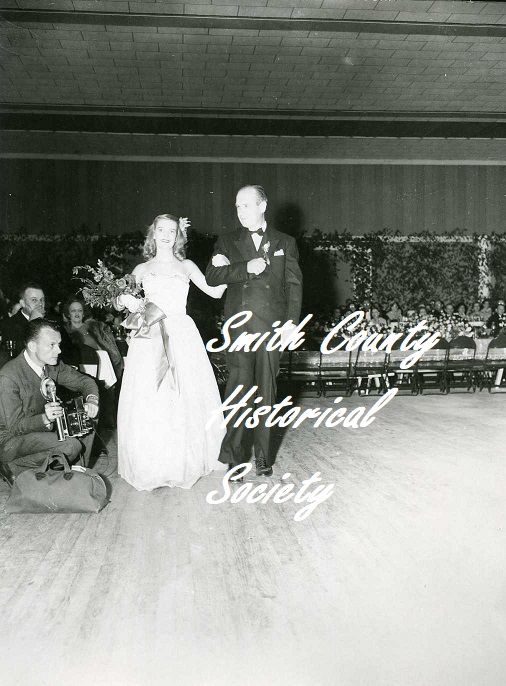Imagine couples dressed to the nines striding arm in arm down a long red carpet before stepping gracefully into a dance hall.
What about a group of giggling teenagers bursting through the doors, excited just to be near their favorite performer; or eager fans scrambling for a ringside seat for an upcoming wrestling match?
Are these images of a future venue or vague memories of a gilded age gone by for Tyler’s historic Mayfair building?
A survey of city stakeholders believe the now vacant and void Mayfair is certainly worth saving, bringing back a venue with a mix of the past and present.
A majority of city council members agree, approving $1.5 million in funding for the project during a June 8 meeting.
“Most of what we heard from our community is that we want to protect the history and culture of this area,” deputy city manager Stephanie Franklin told the council.
“We heard the Mayfair has been a part of true music history in our community, and it’s been a part of music history in a stop on many famous musician tours throughout Texas over time.”
Ashley Washmon, executive director of Historic Tyler Inc., was one of a handful of people who expressed support for the rehabilitation project during the meeting.
“The character, the charm, just that culture of Tyler is synonymous with the historic preservation of the town. I can’t imagine Tyler without our historic buildings. Without those pieces of history, the town would be sterilized,” Washmon said.

Mayfair history
Built in 1929 by local construction company Sam Hill, the building sports a hardwood dance floor built from wood harvested from a pecan grove in north Tyler. In 1938, the stage and floor — which was initially sloped — were changed to accommodate the first Rose Ball, said Ronnie Anderson, who helped organize the group Save the Mayfair.
The stage and dressing rooms are the same ones once occupied by some familiar performers: Elvis Presley, Charley Pride, Dolly Parton, Bo Diddley, Johnny Cash, Minnie Pearl and David Allen Coe, to name a few.
During World War II, the Mayfair became a main attraction for USO dances and movie nights for soldiers stationed at Camp Fannin. Anderson said his wife’s aunt and uncle met at one of those events and later married.
A boxing ring constructed inside the Mayfair played host to professional wrestling family the Von Erichs and numerous Golden Glove competitions.
In the mid 1970s, the Mayfair came under the control of the East Texas State Fair as part of a 50-year lease agreement. The building was one of a group of buildings used for exhibits and other youth events.
Over time, a leaky roof, decay and termites took a toll on the building and left it in disrepair.
In 2016, the East Texas Fair manager proposed demolishing the building due to its condition. It was then Anderson and a friend, Jimmie Horton, discussed the plan over lunch and decided to take action.
They formed Friends of the Mayfair along with Buddy Henderson, Ronnie Stanton, Sam Kidd, the late Randy Clark and late attorney Bill Clark. A city official contacted Historic Tyler, Inc., who gave the group a sizable grant to form Friends of the Mayfair as a 501C3 (non-profit).
The group convinced city officials not to destroy the building which currently is deemed “unsafe.”
Anderson holds many fond memories of the Mayfair as a boy growing up in Tyler. As part of a band at the age of 13, he said he played drums during a performance there.
“The first time I played there, we put our instruments right in the boxing ring and played,” he recalled. “The history of that building is unreal.”

📷 courtesy Smith County Historical Society
Elvis Presley performed in the Mayfair, not once but three times — a historical note that Anderson said attracts attention.
Two different tour groups from Germany visited the U.S. looking through rock’n roll history. They visited New York and Nashville and then traveled to Tyler to stand on the stage where Elvis Presley performed, he said.
“They were all dressed in jeans and white bobby socks and wanted their pictures made on the stage,” Anderson said. “And we gave them a tour of the building.”
Part of a master plan
During the June meeting, Franklin discussed the background of the master plan for renovating the rose complex, recently named the W.T. Brookshire Conference Center. The center will be funded with the city’s hotel occupancy tax, the one-half cent sales tax and private donations.
The Mayfair is located in part of the master plan known as the cultural zone. The cost of restoration is $346.10 per square foot and cost of deconstruction/rebuild is $430-$450 per square foot, Franklin said.
She said there is an effort to look for additional funding through grants — an option council member Stuart Hene, who voted against approving funding — said he preferred.
The cost of rehabilitating the Mayfair is based on a report compiled by local architect Mark Thacker, Washmon said.
WRL General Contractors, LLC was hired previously to oversee the Rose Complex project. The company submitted a bid of a little over $1.5 million for rehabilitating the Mayfair. The bid is good for 30 days due to the rising costs of construction.
“The city council wasn’t voting on whether to approve the restoration or not but whether to approve the finances associated with it,” Washmon said.
She said in order for a building to be considered historic, it must meet three criteria: the building must be at least 50 years old; the building must retain characteristics from the time period of significance; and existence of an association of a historical event or person must be proven.
“Tyler has many historic buildings, but I would argue the Mayfair is one of the most significant in that the history associated with this property transcends both local and state significance,” she said. “These national icons played there, and so I think that’s important to our town. Juxtaposition to the new convention center with this historical building will just add to the whole area for drawing visitors.”
Restoration could begin after the East Texas State Fair ends this fall and is estimated to take nine months to complete the 12,320 square foot building.
“That was very encouraging to hear that they have a timeline and a start date,” said Washmon. “It is a very understated looking building (on the exterior) but once you find out its history …”
Funding needs
Although revenue from the city’s hotel/motel occupancy tax is expected to fund most of the project, Anderson said more funds will be needed to complete the project.
“The building is saved; we have a historical plaque out front and finally reached agreement for funding of $1.5 million to put towards the building,” Anderson said. “Now that that is procured, we need to start raising money for things like the lighting system and a state-of-the art sound system, etc.”
Horton said the Friends of the Mayfair members hope to see the Mayfair become a versatile, medium-sized venue once again with pictures of the numerous stars who performed there on the inside. They also foresee the venue being utilized for all types of events accommodating 400-500 people.
“I’m so satisfied that we saw fit to save the Mayfair building instead of tearing it down and putting up a nondescript building there,” Horton said. “My favorite saying is if history is not remembered, it is lost and gone forever.”
Tax deductible donations for the Mayfair building restoration may be made to Friends of the Mayfair at: P.O. Box 133200, Tyler, Texas 75713.
Pamela Stokes is a freelance writer and tutor for Lufkin Independent School District. Born in Canada, Stokes moved to Texas for high school and graduated from Stephen F. Austin State University. She has worked for the Tyler Morning Telegraph Courier Times and Henderson Daily News. Stokes resides in Lufkin with her two Border Collie mixes.
Love what you're seeing in our posts? Help power our local, nonprofit journalism platform — from in-depth reads, to freelance training, to COVID Stories videos, to intimate portraits of East Texans through storytelling.
Our readers have told us they want to better understand this place we all call home, from Tyler's north-south divide to our city's changing demographics. What systemic issues need attention? What are are greatest concerns and hopes? What matters most to Tylerites and East Texans?
Help us create more informed, more connected, more engaged Tyler. Help us continue providing no paywall, free access posts. Become a member today. Your $15/month contribution drives our work.







